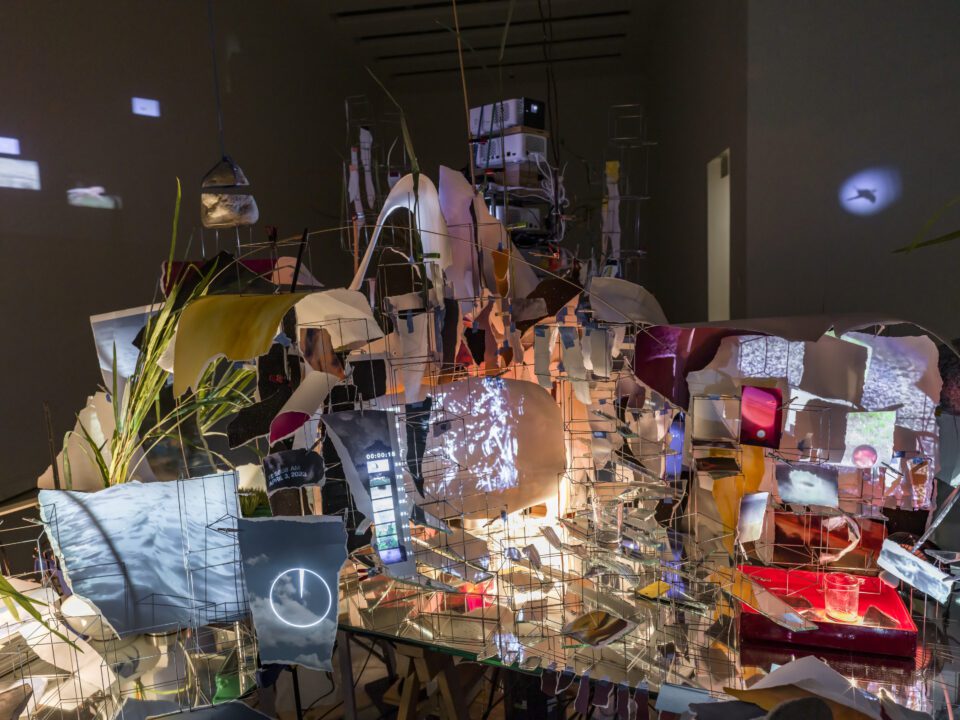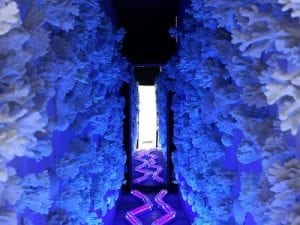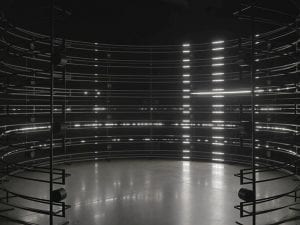If you could list some of the innumerable objects multimedia artist Sarah Sze uses in the site-specific installations in Timelapse, it would be a myriad of items that do not seemingly belong together. Her latest exhibition, now on at The Guggenheim, New York, sees Epson projectors, duct tape, string, inkjet prints, ladders, wood and even a tub of mayonnaise form part of the installation. Although, cataloguing would say no more about the work than identifying all the colours that appear, describing all the video footage or some other doomed attempt at being exhaustive. For this solo exhibition, Sze created a series of site-specific installations that weave a trail of discovery through multiple spaces of the Guggenheim’s iconic Frank Lloyd Wright building.
Sze emerged as an artist in the 1990s and has built a distinct visual language that blurs the boundaries between various mediums including architecture, drawing, painting, print, sculpture, sound and video. She challenges the space between digital and analogue, as well as the permanent and impermanent. A visual of hands working with clay is a recuring motif as seen across several pieces in the show. There are also printed photographs of the sky, ocean, a woman sleeping, cartographic outlines, and so on, which are ripped crudely, displaying white traces of the tear on all sides. Times Zero (2023) includes a painting that resembles a vortex of mashed-up images that have been excavated from a repressed digital subconscious. Sze then mirrors it with a photograph of the same painting, which has been shredded to pieces and collaged back together again. These gestures, plus the carefully placed assortment of items (towers of projectors, pencils, rulers, measuring tape NS iPhone chargers) bind these works together, offering an indication of the artist’s intent to make her labour visible, whilst also mythologising it.

The delicacy and complexity of Sze’s assemblages unfold to the viewer’s delight. In a spherical hollow of a lattice wood structure, there are post-it sized paper screens, which a projector bounces light off a mirror, perfectly aligning in miniscule. Sze recently said in an interview with Frieze (May 2023): “People have a desire to dissect the work and take back control over the objects by turning them into words that can be understood.” Two key works from the museum’s collection bookend the show, and both are exhibited in New York for the first time. Untitled (Media Lab) (1998) is Sze’s first sculpture to incorporate video and Timekeeper (2016) is a monumental, multisensory installation that marks the exhibition’s finale. It is a cornucopia of moving images whose nucleus is an explosive untidy artist’s desk, making the video private and ruminative, akin to writing in one’s own diary.
Time, as it unfolds in the works selected for Sarah Sze: Timelapse, is not only a collection of lived and remembered experiences but, in the words of the artist: “A contemplation on how we mark time and how time marks us.” This is a highly recommended and must-see exhibition.
Sarah Sze: Timelapse
The Guggenheim, New York | Until 10 September
Words: Jasmine Liu
Image Credits:
1. Installation view, Sarah Sze: Timelapse, Things Caused to Happen (Oculus), 2023, March 31— September 10, 2023, Solomon R. Guggenheim Museum, New York. Photo: David Heald © Solomon R. Guggenheim Foundation, New York
2. Installation view, Sarah Sze: Timelapse, Timekeeper, 2016, March 31—September 10, 2023, Solomon R. Guggenheim Museum, New York. Photo: David Heald © Solomon R. Guggenheim Foundation, New York




